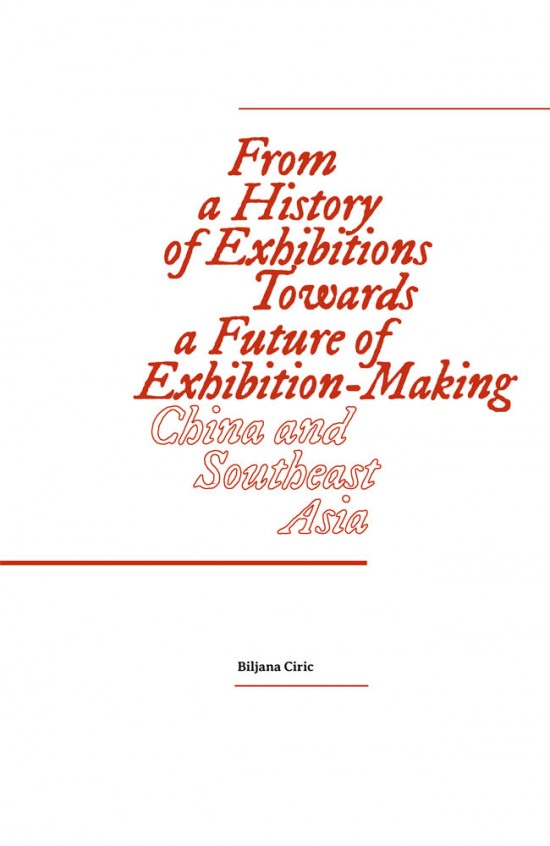From a History of Exhibitions towards a Future of Exhibition-Making: China and Southeast Asia drills deep into the region’s locales and art scenes
This selection of case studies, assembled with the stated intention of establishing a baseline for the exchange of curatorial knowledge and exhibition histories across China and Southeast Asia, drills deep into the region’s locales and art scenes, from Ho Chi Minh City to Taipei, Yangon to Manila, Shanghai, Beijing and Guangzhou to Singapore and Jakarta. The texts emerged from a generously defined – and opportunistically redefined (in the sense that exhibition discourse is a field without deep roots and has needed to find its institutional nourishment where it can) – research platform put together by the volume’s editor, Biljana Ciric, following a first meeting in New Zealand in 2013. Commissioned and assembled over a period of time that has seen rapid growth in the creation of private museums and institution-based exhibitions across the region, this project is well positioned to shape a nascent discourse as well as serve as a calling card for those involved in its production. Given that it started out as a series of conferences, two of them hosted by private museums – the Rockbund Art Museum in Shanghai and the Times Museum in Guangzhou – seeking to establish themselves in a robust, professionalised ecosystem centring on the production and display of contemporary art, it is worth considering the extent to which this is a land-grab, at once justifying the need for this discourse and at the same time taking control of it.

Written by a mix of independent and institutionally affiliated curators, some big names among them, in registers ranging from narrative-based social history to academic, theory-heavy art-historical analysis, the texts in this nearly 500-page publication are clearly intended for a specialist readership, if not the very museums to which its authors might offer their services. Among the 19 included here: a standout study of Taiwan’s underground cultural scenes during the early 1990s and the influence of a nomadic figure named Wu Chung-wei, written by Wei Yu; an analysis of the unintended consequences of establishing
a museum to preserve cultural traditions associated with swidden agriculture in Yunnan, southwestern China, by Maggie J. Zheng; the editor’s own contribution, a history of small- scale, artist-organised events and exhibitions in 1980s China presented as a means of commenting on how to preserve the vitality and diversity of artistic production despite the narrowing of exhibition typologies in the intervening years; Nikita Yingqian Cai’s investigation into the legacy of the members of the Big Tail Elephant collective and their meticulous strategic evasions of the market’s reach and corruptions; two texts by Patrick D. Flores, one positing the ‘exhibition as a problematic’ in the development of a ‘dislocal’ via the figure of Filipino artist Roberto Feleo, another focused on the emergence of abstraction in a 1953 Manila exhibition; an incisive recounting, by Di Liu, of artist collective ruangrupa’s first foray into Mainland China, a 2018 visit to Guangzhou, Shenzhen and Chengdu; an analysis, by Julia Hartmann, of differing approaches to organising exhibitions of ‘women’s art’ in 1990s China and how they reflect and respond to emerging female consciousness in both the artists and society; and so much more.
Ciric has divided the project into three loosely defined time periods, aiming to trace the ways in which exhibition-making has evolved in the region over the past half-century, from artist-organised exhibitions and events during the 1970s and 80s, to the effects of accelerating internationalisation and standardisation during the 1990s, the rise of institutions as the locus for contemporary art discourse, the proliferation of biennales, the influx of Western institutions, the legacy of colonialism in exhibition rituals and the growth in the art market from the 2000s, all with consequences for how art, in turn, is created.
There is surely an undersold and invaluable aspect to this project: the gathering of texts that serve to archive exhibitions mounted in ways, places and times that have made such histories scattered and fragile, for presentation to a global audience of art historians, curators and critics. But in their very diversity of locales and subjects, and in their highly detailed focus, these same texts struggle to work together to provide a comprehensive view of the region. As a pretext for gathering these histories, the promotion of exhibition discourse in the region makes perfect sense, but it begs the question of whether it is possible or even desirable to marshal such diversity into singularity.
From a History of Exhibitions towards a Future of Exhibition-Making: China and Southeast Asia, edited by Biljana Ciric, is published by Sternberg Press